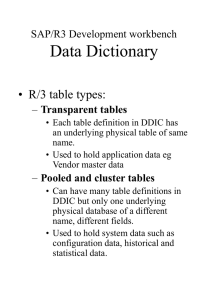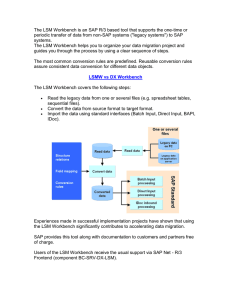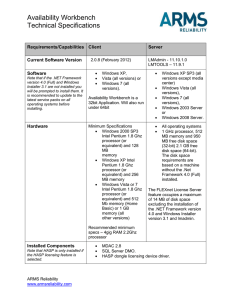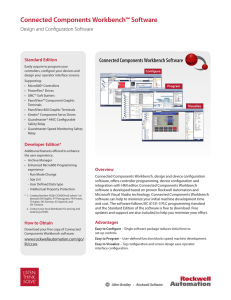Automation of a Complex, Multi-Step Sample Preparation Using the
advertisement
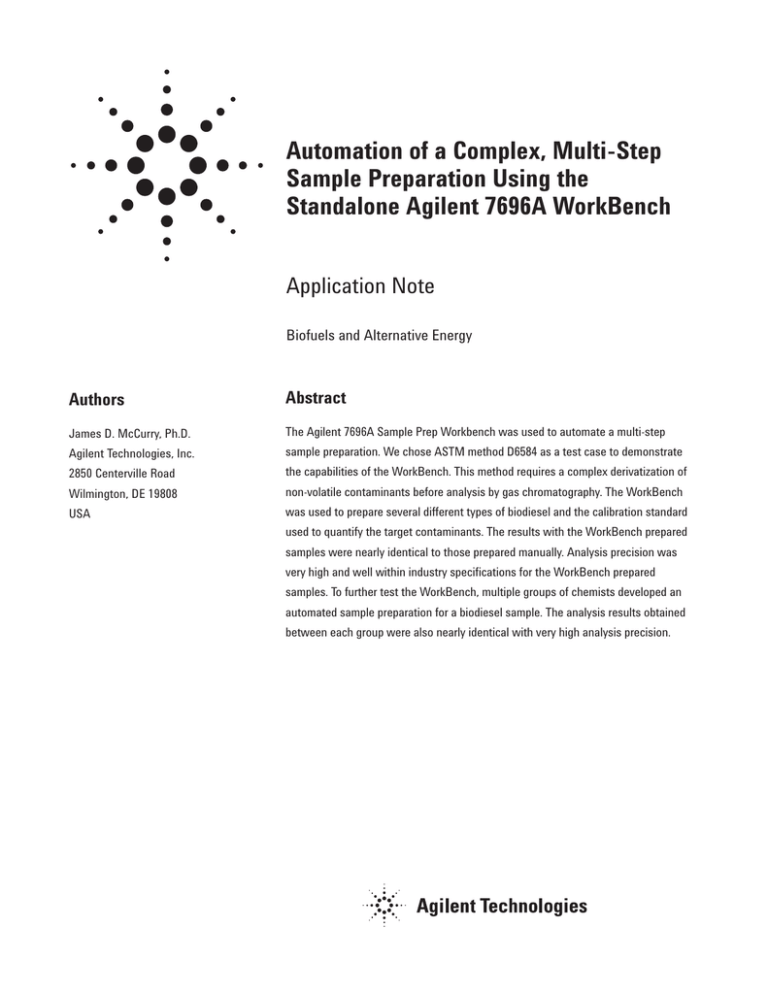
Automation of a Complex, Multi-Step Sample Preparation Using the Standalone Agilent 7696A WorkBench Application Note Biofuels and Alternative Energy Authors Abstract James D. McCurry, Ph.D. The Agilent 7696A Sample Prep Workbench was used to automate a multi-step Agilent Technologies, Inc. sample preparation. We chose ASTM method D6584 as a test case to demonstrate 2850 Centerville Road the capabilities of the WorkBench. This method requires a complex derivatization of Wilmington, DE 19808 non-volatile contaminants before analysis by gas chromatography. The WorkBench USA was used to prepare several different types of biodiesel and the calibration standard used to quantify the target contaminants. The results with the WorkBench prepared samples were nearly identical to those prepared manually. Analysis precision was very high and well within industry specifications for the WorkBench prepared samples. To further test the WorkBench, multiple groups of chemists developed an automated sample preparation for a biodiesel sample. The analysis results obtained between each group were also nearly identical with very high analysis precision. Introduction rically transfer liquids between 2-mL vials. The vials containing various chemical resources, standards and samples are housed in three 50-position trays. The sample tray compartment houses a robotic arm to move vials, a vortex mixing station and a sample heating station. In analytical chemistry, sample preparation can be as simple as adding a solvent or as complex as performing chemical reactions to improve the instrumental measurements that follow. While sample preparation is a critical component to any chemical measurement, chemists rarely look forward to performing this job, especially if it is complex, boring and involves handling unpleasant chemicals. As a result, manual sample preparation can be the source of many errors and poor precision. To help reduce errors and improve precision, many manual sample preparations are done using large amounts of chemicals and expensive volumetric glassware to make handling, dispensing, and measuring easier. Designing the 7896A WorkBench Procedure The ASTM D6584 preparation procedure can be completely described in six individual steps as shown in Table 1. When done manually, this prep consumes large amounts of standards, reagents, solvents and disposable glassware. Since the Agilent WorkBench uses smaller 2-mL vials, this procedure can be scaled down by a factor of 10. The WorkBench also uses two pipetting syringes to transfer liquids, thus eliminating the expense of disposable glassware. Table 1 also shows how each step was scaled to accommodate the 2-mL vials used by the WorkBench. A good example of a difficult manual preparation is ASTM method D6584. This method measures the free and total glycerin content in B100 biodiesel to assure good product quality [1]. Since the various glycerins found in biodiesel are not volatile, they cannot be measured using gas chromatography (GC). Method D6584 describes a sample preparation protocol to derivatize these compounds with a trimethylsilation reagent so they can be analyzed with GC. The steps for this sample preparation are complex, time consuming, and use pyridine, a toxic solvent with a distinctly unpleasant odor. This explains the unpopularity of this sample prep among chemists working with biodiesel. Before building a WorkBench sample prep, we first defined the chemical resources needed to prepare the biodiesel samples and the position of those resources in the WorkBench trays. Table 2 shows each resource, their tray positions and the pipetting syringe parameters used to dispense each resource. The WorkBench software also provides a graphic, overhead view of the resources in the sample trays as shown in Figure 1. In this example, we show 10 samples in tray positions 1 to 10 and 10 n-heptane resource vials that will be used with each sample. The n-heptane vials are stored in tray positions 101 to 110. The Agilent 7696A Sample Prep WorkBench is a standalone instrument specifically designed to perform automated sample preparation [2,3]. It uses two 7693A injection towers to volumet- Table 1. ASTM Method D6584 uses a six step derivatization of Glycerins in Biodiesel to prepare the samples for analysis by high temperature GC. Since the Agilent 7696A Sample Prep WorkBench uses 2-mL vials, the manual sample must be scaled down 10:1 10:1 Scaling & Steps Manual Sample Prep in 15-mL Vials 1 Add 100 mg B100 to a 15-mL vial with PTFE screw cap Add 10 mg B100 to a 2-mL vial with PTFE screw cap 2 Add 100 μL ISTD1 solution (butanetriol) to the vial Add 10 μL ISTD1 solution (butanetriol) to the vial 3 Add 100 μL ISTD2 solution (tricaprin) to vial Add 10 μL ISTD2 solution (tricaprin) to vial 4 Add 100 μL derivatization reagent (MSTFA) to vial and mix Add 10 μL derivatization reagent (MSTFA) to vial and mix 5 React at room temperature for 15 minutes React at room temperature for 15 minutes 6 Add 8 mL n-heptane to vial and mix Add 800 μL n-heptane to vial and mix 2 WorkBench Sample Prep using 2-mL Vials Table 2. Four chemical resources are needed to completely derivatize Glycerins in Biodiesel. The resources, tray positions and syringe parameters are set in the Workbench Software. The syringe draw speeds are used to load each resource into the syringe. The syringe dispense speeds are used to transfer the resource into the 2-mL sample vials Chemical resource Tray position Syringe size (μL) Syringe draw speed (μL/min) Syringe dispense speed (μL/min) ISTD1 (1000 μg/mL butanetriol in pyridine) 51 100 250 500 ISTD2 (8000 μg/mL tricaprin in pyridine 52 100 250 500 MSTFA derivatization reagent 53 100 250 500 n-Heptane 101–110 250 500 2000 Figure 1. The WorkBench software provides an overhead view of each chemical resource in the sample trays. For this example, in addition to the chemical resources, 10 samples were placed in tray positions 1 to 10. Sample weighing cannot be performed using the WorkBench because there is no analytical balance. Since weighing 10 mg of biodiesel can be very challenging, an Eppendorf Reference Adjustable-Volume Pipettor (10–100 μL) was used to transfer the sample. Weighing 10 mg of biodiesel was done by manually pipetting 11.4 μL of biodiesel into tared 2-mL vials and recording the weight to the nearest 0.1 mg. ADD_ISTD1.M to add the first internal standard solution (ISTD1) to every sample before adding the second internal standard (ISTD2) using method ADD_ISTD2.M. With this approach, we only needed to wash the syringe with solvent after switching to a different resource. This greatly reduces the amount of wash solvent needed and allows more samples to be prepared before refilling the wash solvent reservoirs. The final “script” for the WorkBench sample prep, including the syringe wash steps, is shown in Table 3. To run the complete sample prep, each method is run by the WorkBench sequence queue as shown in Figure 2. To mimic the manual sample prep workflow, individual WorkBench methods were created for each step outlined in Table 2. For instance, we created a method called 3 Table 3. A final “Script” showing each step in the sample prep protocol and the corresponding Workbench Methods needed to perform each action Steps Biodiesel preparation protocol Method name Comments 1 Add 10 μL ISTD1 solution to every sample vial ADD_ISTD1.M Uses 100-μL syringe in rear tower 2 Wash 100-μL syringe Wash_Back.M Solvent reservoirs in rear tower 3 Add 10 μL ISTD2 solution to every sample vial ADD_ISTD2.M Uses 100-μL syringe in rear tower 4 Wash 100-μL syringe Wash_Back.M Solvent reservoirs in rear tower 5 Add 10 μL MSTFA reagent to every sample vial and mix ADD_MSTFA.M Uses 100-μL syringe in rear tower 6 Wash 100-μL syringe Wash_Back.M Solvent reservoirs in rear tower 7 React at room temperature for 15 minutes Reaction.M One 15 minute wait time is used for all samples 8 Add 800 μL n-heptane to every sample vial and mix ADD_Heptane.M Uses 250-μL syringe in front tower Figure 2. The WorkBench Sequence Queue is used to run the WorkBench methods described in Table 3. Experimental prepared standards were used to quantify the WorkBench prepared samples. An Agilent 7890A GC was configured to run ASTM D6584. This configuration is outlined in Table 4. The GC conditions used to analyze the biodiesel samples and standards are shown in Table 5. Comparison of manual sample prep and WorkBench sample prep The first question many users will ask is “does a scaled WorkBench sample prep produce the same results as the manual sample prep?”. To help answer that question, two different types of biodiesel samples were prepared using the manual ASTM protocol and the WorkBench. The first biodiesel sample came from a small local producer using canola oil as the feedstock. The second sample was supplied by a national producer using a soybean oil feedstock. For both the manual and WorkBench protocols, each biodiesel sample was prepared and analyzed in duplicate to evaluate the repeatability (single user precision) according to the ASTM method. Preparation of GC calibration standards ASTM D6584 also requires the derivatization of five calibration standards with the same preparation used for the samples. After running the standards by GC, the resulting calibration curves were evaluated for linearity before running any samples. The calibration standards were prepared both manually and with the WorkBench with the same protocol used for the samples. The calibration curves resulting from the manual prep were used to quantify the manually prepared biodiesel samples. The calibrations resulting from the WorkBench 4 Multiuser precision - reproducibility Results In order to evaluate multi-user precision, four different chemists were provided with a soybean biodiesel sample, calibration standards and a WorkBench with the chemical resources shown in Table 2. Each chemist was given the list of sample preparation steps outlined in Table 3 and asked to develop and use a WorkBench protocol. Duplicates of a soybean biodiesel sample were prepared using their WorkBench followed by GC analysis. Preparation of GC calibration standards The 5-level calibration curves for glycerin, monoolein, diolein and triolein are shown in Figure 3. The five standards used to create these curves were prepared with the Agilent WorkBench. The glycerin curve was used to quantify free glycerin in the biodiesel samples. The monoolein curve was used for the monoglycerides, the diolein curve for all diglycerides and the triolein curves for all triglycerides found in the samples. The same calibration standards were also prepared manually and used to construct calibration curves. In Table 6, we compared the calibration models for all four compounds from the manually prepared standards and the WorkBench prepared standards. The manually prepared standards and the WorkBench prepared standards yielded nearly identical calibration curves and the correlation coefficients (r2) from the WorkBench prepared standards exceeded the ASTM specification of at least 0.99 or greater. Table 4. Gas Chromatographic Instrument configuration used to analyze samples using ASTM Method Standard Agilent 7890A GC Hardware G3440A Agilent 7890A Series GC Option 122 Option 211 Cool-On-Column Inlet with EPC control Capillary FID with EPC control G4513A Columns Agilent 7693A ALS Analytical Column Select Biodiesel for Glycerides 15 m x 0.32mm id x 0.1 μm film (p/n cp9078) Agilent Multi-Technique Chemstation Data System Consumables 5181-1267 Table 6. The calibrations curves resulting from manual and WorkBench Preparation Protocols were very similar as shown by the respective slopes and intercepts for each compound. Both preparation Methods met the ASTM requirement for Correlation Coefficient Values (r2) of 0.99 or greater 10 μL PTFE fixed autoinjector syringe Standards and Reagents 5190-1408 5190-1407 Biodiesel D6584 Calibration Standards Kit Biodiesel MSTFA Kit Reagent grade n-heptane Manual Prep Table 5. GC Instrument Conditions for ASTM Method D6584 Cool-on-column inlet Initial temperature 50 °C Temperature program Oven track mode Column flow Helium at 3 mL/min constant flow mode Column Temperature Initial 50 °C for 1 min Rate 1 15 °C/min to 180 °C, hold 0 min Rate 2 7 °C/min to 230 °C, hold 0 min Rate 3 30 °C/min to 380 °C, hold 10 min Flame ionization detector 380 °C 5 WorkBench Compound Slope y-int r2 Slope y-int r2 Glycerin 1.0433 0.0028 0.9997 1.1027 0.0049 0.9995 Monoolein 1.3446 –0.0171 0.9997 1.3786 0.0044 1.0000 Diolein 1.2176 –0.0010 0.9999 1.2086 –0.0014 0.9999 Triolen 0.8303 –0.0018 0.9965 0.8703 1.0000 0.0030 0.6 Glycerin 1000 μg 1.5 0.25 0.4 35 μg Area ratio Area ratio Monoolein 1.75 50 μg 0.5 0.3 25 μg 0.2 500 μg 0.75 0.5 15 μg 0.1 750 μg 0.1 250 μg 100 μg 0.25 5 μg 0 0 0 0.2 0.4 0 Amount ratio 0.5 1.0 Amount ratio 0.6 0.8 Diolein 0.7 500 μg Triolein 0.5 500 μg 0.6 Area ratio Area ratio 0.4 0.5 350 μg 0.4 0.3 0.2 200 μg 0.2 0.1 0 0.2 200 μg 0.1 100 μg 50 μg 0 350 μg 0.3 100 μg 50 μg 0 0.4 0 Amount ratio 0.2 0.4 Amount ratio Figure 3. Calibration curves from standards prepared using the WorkBench. were identical to those prepared manually. Both samples were prepared and analyzed in duplicate to determine the repeatability of the sample preparations. Repeatability (r) is used to measure the precision for a single operator by taking the difference between duplicate analyses of each sample. As seen in Table 7, the samples prepared using the WorkBench exceeded minimum repeatability specification set by ASTM for this analysis. This shows that after a 10-fold reduced scale, samples prepared with WorkBench can easily provide the same precise results as manually prepared samples using much larger amounts of chemicals, reagents and solvents. Comparison of manual sample prep and WorkBench sample prep The biodiesel samples prepared manually and with the WorkBench were analyzed according to ASTM method D6584. Figure 4 shows a comparison of biodiesel sample 1 (canola) chromatograms resulting from the manual prep and the WorkBench prep. In the regions where the various glycerins elute, both chromatograms look identical. For all samples, the free and total glycerins were quantified and the results are listed in Table 7. The WorkBench sample prep yielded results that 6 Glycerin pA Monoglycerides Diglycerides Triglycerides 1000 800 600 Manual Prep 400 200 0 1000 800 600 WorkBench Prep 400 200 0 0 5 10 15 20 25 Min. Figure 4. A comparison of data from a canola biodiesel sample prepared manually and using the Agilent WorkBench. These chromatograms show remarkable similarity in the four regions where glycerin, monoglycerides, diglycerides and triglycerides are separated. Table 7. For two different types of Biodiesels, the WorkBench sample results were nearly identical to the samples prepared manually. The precision (repeatability) observed for the WorkBench samples were well within ASTM Specifications Biodiesel Sample 1 (canola) Manual Prep WorkBench Reproducibility (r) Run 1 Run 2 r Run 1 Run 2 r Specification Free Glycerin 0.000 0.000 0.000 0.000 0.000 0.000 2.58E-04 Monoglycerides 0.169 0.169 0.168 0.163 0.020 0.083 Diglycerides 0.282 0.286 0.291 0.286 Triglycerides 0.533 0.536 0.565 0.554 Total Glycerin 0.984 0.991 1.023 1.003 0.007 Biodiesel Sample 2 (soybean) Manual Prep WorkBench Reproducibility (r) Run 1 Run 2 r Run 1 Run 2 r Specification Free Glycerin 0.008 0.008 0.000 0.008 0.008 0.000 0.002 Monoglycerides 0.138 0.144 0.141 0.140 Diglycerides 0.022 0.023 0.022 0.021 Triglycerides 0.009 0.009 0.006 0.005 Total Glycerin 0.177 0.184 0.176 0.174 0.002 0.046 0.007 7 Multiuser precision - reproducibility shown in Table 8 along with an evaluation of the precision between groups (reproducibility). These results show a very high level of precision when several chemists develop an automated WorkBench protocol for preparing the same sample. Figure 5 shows the same soybean biodiesel sample independently prepared by four different chemists on four different days. The chromatography between each chemists is nearly identical. The quantitative results obtained by each chemist are Glycerin pA 150 Monoglycerides Diglycerides Triglycerides Chemist 1 100 50 pA 150 Chemist 2 100 50 pA 150 Chemist 3 100 50 pA 150 Chemist 4 100 50 2.5 5 7.5 10 12.5 15 17.5 20 22.5 Min Figure 5. A comparison of data from a soybean biodiesel sample prepared by four different chemists working on four different days. Each chemist developed a WorkBench sample preparation protocol and then analyzed the samples using ASTM method D6584. The results are nearly identical. 8 Table 8. Each chemist obtained nearly the same results when using the Agilent WorkBench for Automated Sample Preparation. The precision (reproducibility) was well within the ASTM Specification for multiple operators Chemist 1 Chemist 2 Reproducibility ASTM R Run 1 Run 2 Average Run 1 Run 2 Average (r) Specification 0.000 0.007 0.005 0.094 Free Glycerin 0.004 0.004 0.004 0.004 0.004 0.004 Monoglycerides 0.107 0.114 0.111 0.109 0.118 0.113 Diglycerides 0.032 0.034 0.033 0.033 0.036 0.034 Triglycerides 0.009 0.009 0.009 0.008 0.009 0.008 Total Glycerin 0.152 0.161 0.156 0.154 0.166 0.160 Reproducibility ASTM R Run 1 Chemist 3 Run 2 Average Run 1 Chemist 4 Run 2 Average (r) Specification 0.000 0.007 0.004 0.091 Free Glycerin 0.004 0.004 0.004 0.004 0.004 0.004 Monoglycerides 0.116 0.114 0.115 0.113 0.114 0.113 Diglycerides 0.033 0.033 0.033 0.032 0.033 0.032 Triglycerides 0.007 0.007 0.007 0.006 0.006 0.006 Total Glycerin 0.160 0.157 0.159 0.155 0.157 0.156 Conclusion For More Information This paper demonstrates that a complex, multi-step sample preparation protocol can be automated with the Agilent 7696A WorkBench. Analytical results obtained with WorkBench prepared samples were the same as those obtained using a traditional manual sample preparation. Even after scaling the preparation steps for the 2-mL vials, the quantitative precision was very high with WorkBench prepared samples. Reducing the sample prep scale with the WorkBench also used 10 times less solvents, reagents, and calibration standards. Additionally, there was no need to use disposable glassware and expensive volumetric glassware. For more information on our products and services, visit our Web site at www.agilent.com/chem. References 1. “D6584 Test Method for Determination of Free and Total Glycerine in B-100 Biodiesel Methyl Esters by Gas Chromatography”, ASTM International: 100 Barr Harbor Drive, West Conshohocken, PA, USA, 2010. 2. “Agilent 7696A Sample Prep WorkBench”, Agilent Technologies, Publication Number 5990-6908EN, January 28, 2011. 3. Rebecca Veeneman and Dale Snyder, “Improved Data Quality through Automated Sample Preparation”, Agilent Technologies, Publication Number 5990-6974EN, December 10, 2010. 9 www.agilent.com/chem Agilent shall not be liable for errors contained herein or for incidental or consequential damages in connection with the furnishing, performance, or use of this material. Information, descriptions, and specifications in this publication are subject to change without notice. © Agilent Technologies, Inc., 2012 Printed in the USA April 27, 2012 5990-7525EN
